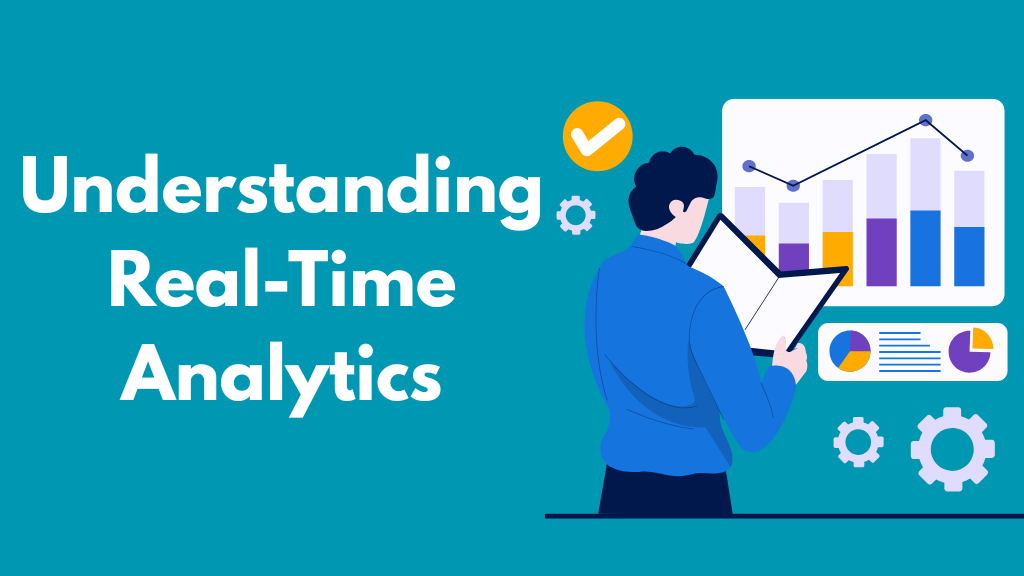


Tejhaksh Technologies is the Website designing & Digital Marketing company based in Neemuch, established in 2020 providing Website design, Website development, Logo design, Domain Registration, Web hosting, Android App Development, eCommerce web development, Search Engine Optimization, Bulk SMS etc. We have good experience in developing different platform websites and we keep our eye on the latest technologies to implement on the website for better conversion and user experience.

In today’s digital world, data is being generated every second—from online shopping clicks and social media interactions to IoT sensors and financial transactions. The speed at which this data is generated is incredible, but what really matters is how quickly businesses can transform it into useful insights.
This is where real-time analytics comes in— the technology that enables organizations to analyze data as soon as it’s generated, helping them make instant, data-driven decisions.
Let’s explore what real-time analytics means, how it works, why it’s important, who can use it, and how it’s shaping the future of business intelligence.
This means analyzing and understanding data as soon as it’s received into the system. Simply put, it helps users see information or results immediately after the data is created or collected.
This instant analysis allows businesses to act quickly—they can seize new opportunities or solve problems before they become major issues.
In comparison, traditional or batch analytics takes a significant amount of time to process information—sometimes hours or even days. This means that the insights generated are available after events have already occurred. With data analytics, companies can stay ahead of the curve by making quick, smart, and proactive decisions.
Example:
The process of real world analytics involves several key steps and techniques that work together. Let’s understand this process step-by-step:
The first step is to bring together all your data from various sources. Data is continuously collected from multiple sources, such as:
Websites and mobile apps
Social media platforms
IoT sensors and smart devices
Financial transactions
CRM and ERP systems
These data streams are connected to a stream processor using specialized tools that continuously send data from one system to another.
Once the data is collected, it is streamed through platforms like Apache Kafka, Amazon Kinesis, or Google Cloud Pub/Sub, which handle massive amounts of live data.
A good stream processor should have these qualities:
Streaming data is instantly cleaned, filtered, and processed using stream processing engines, such as:
Apache Spark Streaming
Apache Flink
Azure Stream Analytics
These tools allow businesses to detect patterns, trends, and anomalies in reality.
Finally, insights are displayed using dashboards and visualization tools such as:
Power BI
Tableau
Looker
Grafana.
These help decision-makers quickly see and act on key metrics.
Once the data is ready, real-world data analytics tools come in. These tools help you:
Modern businesses operate in a fast-paced environment where customer preferences and market conditions change within minutes. Waiting hours or days for reports can mean missed opportunities or even losses.
Below are the details of why analytics has become a game-changer:
Instant Decision-Making:
Businesses can take immediate action when any type of problem or opportunity arises.
Improved Customer Experience:
Personalized suggestions, faster service, and immediate problem-solving improve satisfaction.
Fraud Detection:
Real time systems detect unusual transactions or login attempts, preventing financial fraud.
Operational Efficiency:
Companies can continuously monitor operations, reducing downtime and improving productivity.
Competitive Advantage:
Real time insights allow businesses to take action before their competitors and spot trends early.
When comparing the two, it’s important to understand that they each have their own strengths and serve different business needs. Now, let’s understand the main differences in detail:
1. Data Processing
The most fundamental difference lies in the data processing method.
Real Time Analytic: It processes data instantly, or within seconds of its creation. This allows businesses to respond to events as they occur. For example, a banking app can detect fraudulent transactions the moment they occur.
Traditional Analytics: In contrast, traditional analytics operates on a batch-processing model. Data is collected over a period of time (hours, days, or weeks) and then analyzed. This method provides post-event information, making it useful for long-term reviews but not for immediate action.
2. Decision Making
Real Time Analytic’s: This enables organizations to make immediate decisions based on live information. Whether adjusting product prices, detecting system errors, or sending personalized offers, decisions are made almost instantly.
Traditional Analytics: However, traditional analytics focuses on delayed decision-making. It uses historical data to identify trends and patterns that guide strategic planning, such as quarterly reports or annual forecasts.
3. Use Cases
Real Time Analytic: This is ideal for scenarios that require immediate response, such as live performance monitoring, fraud detection, stock trading, and personalized suggestions on e-commerce sites.
Traditional Analytics: More effective for historical reporting and forecasting. It helps businesses analyze past performance, customer trends, and financial results to shape future strategies.
4. Infrastructure
Real Time Analytic: Relies on a stream-based infrastructure that can handle continuous data flow. Technologies like Apache Kafka, Spark Streaming, and Amazon Kinesis are designed for this purpose.
Traditional Analytics: On the other hand, traditional analytics is database-driven, where data is first stored, organized, and then analyzed in batches using systems like SQL databases or data warehouses.
5. Business impact
Real Time Data Analytic: Offers the advantage of quick response and adaptability. It helps businesses respond to opportunities or risks as they arise, ensuring agility and competitiveness.
Traditional Analytics: Aids long-term strategic decision-making. By analyzing data spanning months or years, it helps organizations make informed decisions about future growth, budgeting, and market expansion.
It is no longer just limited to tech giants. Today, nearly every industry is taking advantage of it. Here are some examples:
1. E-commerce
Platforms like Amazon and Flipkart analyze browsing and purchasing patterns in real data time to provide dynamic pricing and personalized recommendations.
2. Banking and Finance
Banks use it to detect fraud, monitor transactions, and quickly assess credit risks.
3. Healthcare
Hospitals use it to track patients’ vital information through Internet of Things (IoT) devices, providing immediate alerts for medical emergencies.
4. Telecommunications
Telecommunication operators monitor network performance in real data time to prevent network disruptions and optimize bandwidth.
5. Retail
Physical stores use it to analyze footfall data and adjust staffing or product placement.
6. Manufacturing
Sensors on machines instantly detect malfunctions or breakdowns, reducing downtime.
7. Marketing and Advertising
Marketers track campaign performance live and adjust budgets or content based on audience behavior.
Fast Decision Making – No need to wait for reports; managers can take immediate action. It offers many powerful benefits for modern businesses. By analyzing live data, companies can make smarter, faster, and more accurate decisions. Let’s take a look at the benefits of real time data:
1. Instantly Track Customer Behavior
2. Save Costs and Improve Efficiency
3. Gain a Competitive Advantage
4. Respond Quickly to Market Changes
5. Test and Improve Instantly
To implement real time data analytics tools, businesses rely on advanced software and frameworks. Let’s take a look at the most popular tools and technologies:
1. Apache Kafka
A leading open-source platform for building real data pipelines and streaming apps.
2. Apache Spark Streaming
It is used for data processing and advanced analytics like machine learning.
3. Amazon Kinesis
AWS’s powerful tool for data streaming and analysis at any scale.
4. Google Cloud Dataflow
It automates and manages data processing in the cloud.
5. Snowflake
A cloud data warehouse that supports fast, live data queries.
6. Power BI and Tableau
Visualization tools that help transform real-time data into actionable dashboards.
7. Redis and InfluxDB
Databases optimized for efficiently storing live data streams.
Also Read:
Google Analytics Explained: 10 Key Reasons Every Website Needs It
What is 5G? A Complete Guide to How It Works, Its Advantages and Disadvantages
Struggling to Get Website Traffic After the Google Update? Try These 8 Proven Methods
Top 10 Signs Your Website Needs a Redesign – And How to Fix Them
1. Netflix
Netflix recommends shows and instantly adjusts streaming quality by analyzing millions of viewing sessions in real times.
2. Uber
uses real time’s analytics to match riders with drivers, optimize routes, and calculate surge pricing.
3. Amazon
recommends products, adjusts prices, and prevents fraud in real time’s by tracking customer activity on its platform.
4. Airlines
monitor live flight data, fuel consumption, and weather conditions to ensure safety and efficiency.
5. Social media platforms
Facebook, Twitter, and Instagram use it to recommend posts, detect spam, and manage trending topics.
The future of analytics is fast, intelligent, and automated. As AI (Artificial Intelligence) and machine learning integrate with real word analytics, its possibilities multiply.
1. AI-Driven Automation
Artificial intelligence will not only analyze data but also automatically take action—for example, detecting and preventing fraud in real times.
2. Edge Analytics
Instead of sending data to a central server, edge devices (such as IoT sensors) will process data locally for faster insights.
3. Predictive + Real-Time Fusion
The combination of real time’s and predictive analytics will help businesses anticipate events before they happen.
4. Integration with 5G and IoT
As 5G enables ultra-fast connectivity, it will become even more instantaneous and data-rich.
5. Improved data privacy and security
As data flows will be in real times, privacy regulations and encryption technologies will evolve to ensure security.
If your business wants to adopt real-world analytics, follow these simple steps below:
Real time analytics is no longer a luxury—it’s a necessity for modern business success. Organizations that can analyze and act on data instantly gain a powerful edge over competitors. From improving customer experience to preventing fraud, real data insights are transforming industries worldwide.
As technology continues to evolve, the combination of AI, machine learning, IoT (Internet of Things), and real times analytics will define the next generation of data-driven decision-making.
So, whether you’re a small startup or a global enterprise, investing in real world analytics today means preparing for a future of instant, intelligent business decisions.
Leave a Comment